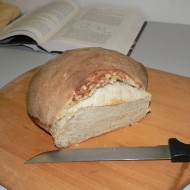Pinterest

Do you Love this website? Please donate to help keep the site going.
Thanks

|

|
|
Sunday, 16 September 2007 06:00 |
Makes 2 Large round flat loaves, or 3 smaller round loaves.
These big, crusty wheels of country bread originated from much darker loaves, a legacy of Turkish conquerors who baked their chewy coarse bread in wood burning stoves. In Italy today the still bow to tradition by making these loaves with less refined flours. To me they are the best of all possible rustic breads, perfect for picnics and informal eating. This is the bread of the poor served with typical food of the region: greens, fish from the sea, cheese, and fruit.
Ingredients
- 1 1/4 tsp dry active yeast
- 1/4 cup warm water
- 3 cups of water, room temperature
- 4/5 cup biga (see other biga recipe)
- 7 1/2 cups unbleached, all purpose flour
- 1 tbs plus 1 tsp salt.
|
 |
Instructions:
- Stir the yeast into the warm water in a large mixing bowl; let stand until creamy, about 10 minutes.
- Add 3 cups water and the biga, and mix with the paddle until well blended.
- Add the four and salt; mix until the dough comes together and pulls away from the side of the bowl, 1 -2 minutes.
- You may need to add another 1 - 2 tbs flour.
- Change to the dough hook, and knead at medium speed for 3 - 5 minutes.
- The dough will be very soft and elastic, but will never pull entirely away from the bottom of the bowl.
- If you want, finish kneading by hand on a floured surface with floured hands until the dough loses it's stickiness and is soft and velvety, about 1 minute.
First rising:
- Place the dough in a lightly oiled large bowl or plastic tub, cover tightly with plastic wrap, and let rise until tripled, about 3 hours.
- Do not punch down.
Shaping and second rising:
- Flour your work surface generously, flour a dough scraper, and have a mound of flour nearby for your hands.
- pour the dough out of the bowl, flour the top, and cut into 2 or 3 equal pieces, depending on how many loaves you are planning.
- Flatten each piece of dough and roll it up lengthwise, using your thumb as a guide for how tight the rolls should be.
- Turn the dough 90 degrees, pat it flat, then roll up again still using your thumbs as a guide.
- Shape each piece into a ball by rolling the dough between your cupped hands, and using the surface of the work table to generate tension, and pull the dough taut across the skin of the dough.
- Place the loaves on floured parchment paper; set on baking sheets or peels, cover with a heavy towel or cloth, and let rise until doubled, about 1 hour.
Baking:
- 30 minutes before baking, heat the oven with baking stones in it to 450 degrees.
- 5 - 10 minutes before baking, flour the tops of the loaves and dimple them all over with your finger tips.
- The imprints will disappear but will keep the bread from rising crazily in the oven.
- Let stand 5 - 10 minutes.
- The loaves will feel as soft as a babies bottom when ready to bake, although you will notice a bit of resistance in the dough.
- Sprinkle the stones with corn meal.
- Italian bakers turn the doughs over into the oven very carefully with a swooping motion that scoops up some of the flour on the peel. you may prefer to slide the loaves onto the baking stones without turning them over, or if they are on baking sheets, the loaves can be baked directly on the pans.
- Bake until golden brown and crusty, about 50 - 60 minutes for the larger loaves, 30 - 35 minutes for the smaller ones.
- Check by tapping on the bottom of each loaf and listening for the hollow ring that indicates it is cooked through, but if you are in doubt, bake for the longer time indicated.
- Cool on racks.
|
|

